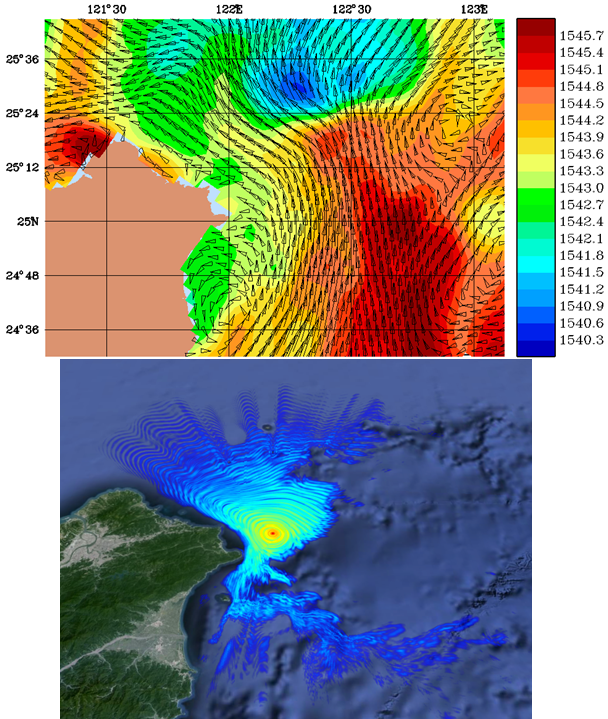|
P.F.J. Lermusiaux, P.J. Haley, Jr. Massachusetts Institute of Technology
K. Heaney
D. Jones |
Ongoing MIT-MSEAS Research Background information
|

|
| This STTR research is sponsored by the Office of Naval Research | ||
Ongoing MIT-MSEAS Research
Objectives: The primary goal of the MIT component is to provide expertise in ocean modeling, data assimilation and uncertainty quantification for coupled oceanographic-acoustic predictions. The specific goals are to:
Characterize and Forecast Oceanographic Variability and Uncertainty
The MIT team provides forecast and hindcast simulations of the uncertainty in the environment. In such high-fidelity multi-resolution simulations, the probability density function of the full ocean state is predicted by an ensemble of simulations that integrate model estimates with observations. The scheme for such data-assimilative field and uncertainty prediction is the Error Subspace Statistical Estimation (Lermusiaux, 2007). Dynamically-balanced stochastic forcing are included (Lermusiaux, 2006), so as to represent effects of sub-grid-scales not resolved by the deterministic model equations. The results are stochastic partial differential equations that allow to capture both deterministic effects (advection, Coriolis, etc.) and statistical effects (smaller-scale turbulence, internal wave variability, etc.) on the environment. With this modeling and data assimilation, accurate estimates of the probability density functions (pdf) of oceanographic variability are available. They become inputs to our end-to-end oceanographic-seabed-acoustic-sonar probabilistic TDAs and thus allow us to estimate and forecast realistic acoustic vulnerability. These oceanographic pdf estimates are provided by the MIT team for the East China Sea, Taiwan and Kuroshio region. Other regions which involve operationally relevant ocean-acoustic studies, e.g. the Middle Atlantic Bight Shelfbreak front region, as well as the Kauai Strait and Hawaiian Islands region (see also here) can also be utilized.
Combine MSEAS with OASIS acoustics to generate realistic scenario in East Asian Seas.
The above components are combined to form an interdisciplinary system for assessing sonar system performance and vulnerabilities. Such an end-to-end system (Lermusiaux et al, 2002; Lermusiaux and Robinson, 2004), couples and integrates data and models from meteorology, physical oceanography, geoacoustics, ocean acoustics, bottom, noise, target and sonar. This approach was exercised and validated in the northeastern Taiwan region within the context of both the 2008 Quantifying, Predicting, and Exploiting Uncertainty (QPE 2008) pilot experiment (Lermusiaux et al, 2010) and the QPE IOP09 real-time exercise.
| Top of page |
Background information
For this research, we utilize our MIT Multidisciplinary Simulation, Estimation, and Assimilation System (MSEAS) (Haley and Lermusiaux, 2010). The MSEAS software is used for fundamental research and for realistic simulations and predictions in varied regions of the world's ocean (Leslie et al, 2008; Onken et al, 2008; Haley et al, 2009; Gangopadhyay et al, 2011; Ramp et al, 2011), including monitoring (Lermusiaux et al, 2007), ecosystem prediction and environmental management (Besiktepe et al, 2003; Cossarini et al, 2009) and, importantly for the present project, real-time oceanographic-acoustic predictions and coupled data assimilation (e.g. Lermusiaux et al, 2002; Robinson and Lermusiaux, 2004; Xu et al, 2008; Lam et al, 2009; Duda et al, 2011; Colin et al, 2013).
Integral to our proposed uncertainty prediction is our Error Subspace Statistical Estimation for ensemble forecasting and data assimilation (Lermusiaux, 2006, 2007). Recently, this capability of forecasting probability density function for ocean dynamics has been augmented with the Dynamically Orthogonal differential equations (Sapsis and Lermusiaux, 2012; Ueckermann et al., 2013; Sapsis et al., 2013) and the Gaussian Mixture Models (GMMs) for nonlinear non-Gaussian filtering (Sondergaard, 2011; Sondergaard and Lermusiaux, 2013a,b).
The MIT and OASIS groups (e.g. Lermusiaux, Heaney and others in the two groups) have had several long-term collaborations. One example consists of the Quantifying, Predicting and Exploiting Uncertainty - Departmental Research Initiative (QPE DRI). During the QPE IOP09 real-time exercise of 18 Aug. - 10 Sep. 2009, real-time nowcast and forecast products with dynamics and uncertainty descriptions and adaptive sampling recommendations were provided by MIT for physical (T, S, velocity) and acoustical (sound speed and transmission loss) variables. Products were produced for a large (regional) area and a zoom of the operational area of interest. It is critical to note that the ocean physics and the acoustics were coupled, i.e. each of the forecasts for the acoustic performance prediction were run using the range and time-dependent ocean forecasts.
Most of the publications cited in the above descriptions are available from: http://mseas.mit.edu/publications
| Top of page |



